Population impact of malaria control interventions in the health district of Kati, Mali
- PMID: 39739743
- PMCID: PMC11687661
- DOI: 10.1371/journal.pone.0289451
Population impact of malaria control interventions in the health district of Kati, Mali
Abstract
Background: WHO and its partners have adopted alternative control interventions since the failure to eradicate malaria worldwide in the 1960s and 1970s. The aim of these interventions has been to redesign the control interventions to make them more effective and more efficient. The purpose of this study is to assess the population impact of control interventions implemented at the community health area level.
Methods: The analysis used data from the health information system on malaria cases and interventions (distribution of long-lasting insecticide-treated nets (LLINs), seasonal malaria chemoprevention (SMC), access to rapid diagnostic tests (RDT), intermittent preventive treatment for pregnant women (IPTp)) collected in the Kati health district from 2017 to 2020. And the contextual parameters (temperature, normal difference vegetation index (NDVI) and rainfall) were obtained by remote sensing. A generalized additive model was used to assess the impact of malaria control interventions on malaria cases as a function of meteorological factors.
Results: The incidence of malaria varies from year to year and from health area to health area, as do meteorological factors in the study area. The distribution of long-lasting insecticide-treated nets, chemoprevention of seasonal malaria in children and access to rapid diagnostic tests for malaria were found to have a significant impact on the incidence of malaria in the population. Seasonal malaria chemoprevention was effective in reducing the incidence of malaria, while distribution of long-lasting insecticide-treated nets and access to rapid diagnostic tests increased with the number of malaria cases, reflecting efforts to distribute and use bed nets and to diagnose malaria cases among the population in the study area.
Conclusion: The study showed the impact of SMC on reducing malaria cases in the population and the significant efforts in LLIN distribution and malaria case diagnosis. To further reduce the burden of malaria, sustained efforts and new interventions are needed, including improving access to rapid diagnosis and treatment in communities by developing community health workers and locally tailored mass drug administration.
Copyright: © 2024 Katile et al. This is an open access article distributed under the terms of the Creative Commons Attribution License, which permits unrestricted use, distribution, and reproduction in any medium, provided the original author and source are credited.
Conflict of interest statement
The authors have declared that no competing interests exist.
Figures




Similar articles
-
Impact of Control Interventions on Malaria Incidence in the General Population of Mali.J Epidemiol Glob Health. 2025 Mar 12;15(1):40. doi: 10.1007/s44197-025-00381-2. J Epidemiol Glob Health. 2025. PMID: 40072686 Free PMC article.
-
Combining next-generation indoor residual spraying and drug-based malaria control strategies: observational evidence of a combined effect in Mali.Malar J. 2020 Aug 15;19(1):293. doi: 10.1186/s12936-020-03361-y. Malar J. 2020. PMID: 32799873 Free PMC article.
-
An observational analysis of the impact of indoor residual spraying with non-pyrethroid insecticides on the incidence of malaria in Ségou Region, Mali: 2012-2015.Malar J. 2018 Jan 10;17(1):19. doi: 10.1186/s12936-017-2168-2. Malar J. 2018. PMID: 29316917 Free PMC article.
-
Piperonyl butoxide (PBO) combined with pyrethroids in insecticide-treated nets to prevent malaria in Africa.Cochrane Database Syst Rev. 2018 Nov 29;11(11):CD012776. doi: 10.1002/14651858.CD012776.pub2. Cochrane Database Syst Rev. 2018. Update in: Cochrane Database Syst Rev. 2021 May 24;5:CD012776. doi: 10.1002/14651858.CD012776.pub3. PMID: 30488945 Free PMC article. Updated.
-
Piperonyl butoxide (PBO) combined with pyrethroids in insecticide-treated nets to prevent malaria in Africa.Cochrane Database Syst Rev. 2021 May 24;5(5):CD012776. doi: 10.1002/14651858.CD012776.pub3. Cochrane Database Syst Rev. 2021. PMID: 34027998 Free PMC article.
References
-
- Mouchet J. Biodiversité du paludisme dans le monde. Paris: J. Libbey Eurotext; 2004.
-
- Organisation mondiale de la Santé,. Stratégie technique mondiale de lutte contre le paludisme 2016–2030, édition 2021 [Global technical strategy for malaria 2016–2030, 2021 update]. Genève, Organisation mondiale de la Santé, 2021. Licence: CC BY-NC-SA 3.0 IGO. 2021.
-
- Organisation mondiale de la Santé. La Déclaration d’Abuja et le plan d’action: extrait du Sommet africain pour faire reculer le paludisme, Abuja, 25 avril 2000 (WHO/CDS/RBM/2000.17). Organisation mondiale de la Santé; 2003.
-
- World malaria report 2020: 20 years of global progress and challenges. Geneva: World Health Organization; 2020. Licence: CC BY-NC-SA 3.0 IGO. [Internet]. 2021 [cité 5 déc 2022]. Disponible sur: https://www.who.int/publications/i/item/9789240015791.
MeSH terms
LinkOut - more resources
Full Text Sources
Medical

